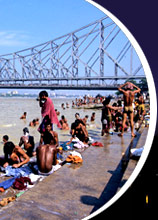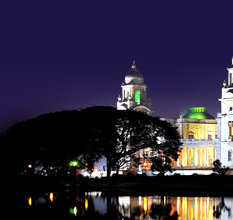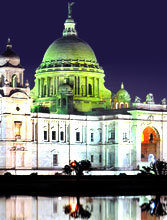 If you want to get an experience of the regal age and imperial glory in West Bengal, Cooch Behar is an idyllic retreat. Situated in the foothills of the Eastern Himalayas, it is the only planned town in North Bengal region, with remnants of a royal heritage. Once the seat of the princely state of Koch Bihar, ruled by the Koch dynasty; Cooch Behar gained its present status three years after Indian independence. The princely state was transformed into Cooch Behar District, with Cooch Behar town as its headquarters. Cooch Behar town is also the largest the town in the district.
If you want to get an experience of the regal age and imperial glory in West Bengal, Cooch Behar is an idyllic retreat. Situated in the foothills of the Eastern Himalayas, it is the only planned town in North Bengal region, with remnants of a royal heritage. Once the seat of the princely state of Koch Bihar, ruled by the Koch dynasty; Cooch Behar gained its present status three years after Indian independence. The princely state was transformed into Cooch Behar District, with Cooch Behar town as its headquarters. Cooch Behar town is also the largest the town in the district.Going down to the pages of history, it is seen that Cooch Behar gained its name from the indigenous Koch tribe, which resided in the place for centuries. The word ‘behar’ is take from the Sanskrit word ‘bihar’, which means to travel. Cooch Behar was a part of the Kamarupa Kingdom, from the 4th century to the 12th century. From the 15th century and till the beginning of the 18th century, the district was ruled by the Koch rulers. However, in the last quarter of the 18th century, the princely state was captured by the King of Bhutan. To expel the Bhutanese, Cooch Behar signed a treaty with the British East India Company, thus becoming a feudal ruler under the British.
The princely-state of Cooch Behar reached its zenith during the rule of Nripendra Narayan, who is also fondly remembered as the ‘architect’ of modern Cooch Behar town. Till date, the town proudly flaunts the magnificent colonial structure of Cooch Behar Palace, the dwelling of the first family of Cooch Behar. Apart from that, it extends visitors the mesmerizing and enthralling structure of Madan Mohan Temple and Baneswar Siva Temple. Apart from the numerous tourist attractions in Cooch Behar, there are number of must-see sites near the place as well, including Rasikbil, Kholta Ecotourism Spot, Alipurduar and Chilapata Forest.
The rich heritage of Cooch Behar is well reflected in its cultural diversity, which is a mixture of those found in West Bengal and Bangladesh. People of Cooch Behar celebrate every festival with great fervor and enthusiasm. Durga Puja and Ras Purnima are the main festivals practiced in the region. However, other festivals, such as Pohela Baishakh, Rathayatra, Dolyatra, Diwali, Poush parbon, Christmas and Eid, are also celebrated here. Talking about food, rice and fish are the staple food of the region. And if you are visiting the place during festivity, do not leave until you taste the appetizing bhuna khichuri and labra!!
Cooch Behar Excursions
Cooch Behar is synonymous with the grandeur and sumptuousness of the golden era. Home to extravagantly designed palaces and divine temples, the place possesses a rich cultural, historical and traditional heritage that is ancient as well as magnificent. For tourists, Cooch Behar is nothing less than a paradise.
Cooch Behar History
Cooch Behar boasts of a rich history and origin, dating back to the 4th century. A part of the Kamarupa Kingdom, it was in the 12th century that the area became a part of the Kamata Kingdom, initially ruled by the Khen dynasty, from their capital at Kamatapur. The aboriginal tribe of the place, Khens ruled the state till 1498 CE, before it fell to Alauddin Hussein Shah
How to Reach
Once a princely state, Cooch Behar is the district headquarters and the largest town of Cooch Behar District, in the Indian state of West Bengal. It is the only planned city in the North Bengal region and boasts of a royal and imperial heritage.
Tourist Attractions
Once a princely state, Cooch Behar boasts of a glorious past, filled with rich culture and heritage. It is the only planned town in the whole of North Bengal. Located on the eastern side of West Bengal, Cooch Behar shares its borders with Assam in the east and neighboring country Bangladesh, in the south.
Cooch Behar Weather
Cooch Behar is one of the important cities of the Duars, in West Bengal. A tourist destination, the place promises royal and imperial glory to its visitors, enveloped by cool and pleasant temperature. The weather in Cooch Behar remains moderate throughout the year, rarely going to the extreme.








